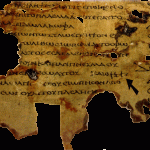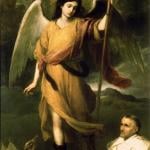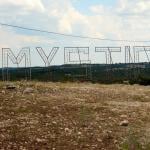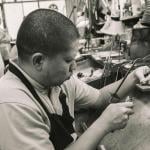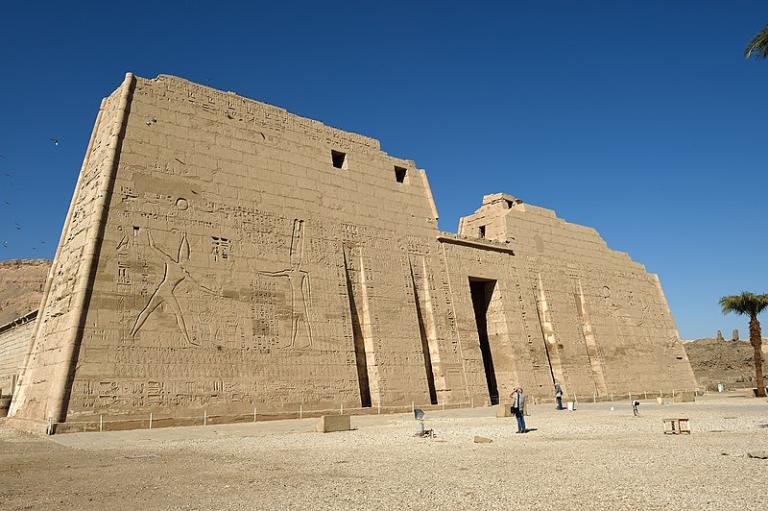
(Wikimedia Commons public domain photograph)
***
Another article — this one by John Gee — has gone up today in Interpreter: A Journal of Latter-day Saint Faith and Scholarship:
““Put Off Thy Shoes from Off Thy Feet”: Sandals and Sacred Space”
Abstract: While many have written on ancient temples looking at the big picture, John Gee discusses one small detail on a single Egyptian temple from the New Kingdom. He focuses on depictions of Ramses III in and out of the temple of Medinet Habu. Outside the temple and when entering and leaving there are depictions of him wearing sandals. Inside the temple proper the king is always shown barefoot. Ramses III built Medinet Habu only slightly after the time of Moses and as Gee further notes, while not wearing footwear was a clear practice among the Egyptians it is far more explicit in Moses’ encounter with Deity when he is told to remove his “shoes from off they feet, for the place whereon thou standest is holy ground.” Gee observes that contemporary Egyptian temple practice “reflects the commands of God recorded in the Pentateuch,” as well as reflects Moses’ Egyptian background.
***
And, as I’ve been doing lately, I now offer links to some articles from a prior volume of Interpreter:
Daniel C. Peterson, “Looking Back, Almost Five Years On”
Abstract: As the axiom states, hindsight is 20/20. As Volume 24 of Interpreter: A Journal of Mormon Scripture nears the press, it seems relevant to look back to a tumultuous time nearly five years ago when the Interpreter Foundation was visualized and launched. If history has any value at all (particularly recent history), it provides a context for understanding the course on which we find ourselves. For the Interpreter Foundation, that course continues to be full of surprises and promise.
Taylor Halverson, “Deuteronomy 17:14–20 as Criteria for Book of Mormon Kingship”
Abstract: Deuteronomy 17:14–20 represents the most succinct summation in the Bible of criteria for kingship. Remarkably, the Book of Mormon narrative depicts examples of kingship that demonstrate close fidelity to the pattern set forth in Deuteronomy 17 (e.g., Nephi, Benjamin, or Mosiah II) or the inversion of the expected pattern of kingship (e.g., king Noah). Future research on Book of Mormon kingship through the lens of Deuteronomy 17:14–20 should prove fruitful.
Collin Charles Russell, “Meeting Zoram”
Abstract: Zoram, the servant of Laban, is a character from the Book of Mormon who is only mentioned a few times and on whom little information is given. This article analyzes what information is given in the Book of Mormon and contextualizes its historical background, all coupled with the observations of Latter-day Saint Church leaders and scholars. Insight is provided concerning Zoram’s Hebraic descent in the tribe of Manasseh and his working duties under Laban’s command, along with how all this affected his role in assisting Lehi’s family. The meaning of his name in Hebrew and possible correlations to the meaning of his life’s events are explained. The oath between Nephi and Zoram is discussed, and the debate regarding whether Zoram was a slave or servant is addressed, to show that he was likely a free servant.
Abstract: Joseph Smith used the term the Urim and Thummim to refer to the pair of seer stones, or “interpreters,” he obtained for translating the Book of Mormon as well as to other seer stones he used in a similar manner. According to witness accounts, he would put the stone(s) in a hat and pull the hat close around his face to exclude the light, and then he would see the translated text of the Book of Mormon. By what property or principle these stones enabled Joseph Smith to see the translated text has long been a matter of conjecture among Mormons, but the stones have commonly been understood as divinely powered devices analogous to the latest human communications technology. An alternative view, presented here, is that the stones had no technological function but simply served as aids to faith. In this view, the stones did not themselves translate or display text. They simply inspired the faith Joseph Smith needed to see imaginative visions, and in those visions, he saw the text of the Book of Mormon, just as Lehi and other ancient seers saw sacred texts in vision. Although Joseph Smith also saw visions without the use of stones, the logistics of dictating a book required the ability to see the translated text at will, and that was what the faith-eliciting stones would have made possible.
Abstract: This paper looks at the Book of Mormon through the lens of library science and the concept of archival provenance. The Nephites cared deeply about their records, and Mormon documented a thorough chain of custody for the plates he edited. However, ideas of archival science and provenance are recent developments in the western world, unknown to biblical authors or to anyone at Joseph Smith’s time. Understanding this aspect of Mormon’s authorship and Joseph Smith’s translation provides additional evidence to the historical validity of the Book of Mormon.
[Editor’s Note: This article is an updated and extended version of a presentation given at the Third Interpreter Matthew B. Brown Memorial Conference: The Temple on Mount Zion, November 5, 2016, at Brigham Young University in Provo, Utah. For a video version of the presentation, see https://interpreterfoundation.org/conferences/2016-temple-on-mount-zion-conference/2016-temple-on-mount-zion-conference-videos/]
Abstract: In chapter 3 of the Gospel of John, Jesus described spiritual rebirth as consisting of two parts: being “born of water and of the spirit.”1 To this requirement of being “born again into the kingdom of heaven, of water, and of the Spirit,” Moses 6:59–60 adds that one must “be cleansed by blood, even the blood of mine Only Begotten; … For … by the blood ye are sanctified.”2 In this article, we will discuss the symbolism of water, spirit, and blood in scripture as they are actualized in the process of spiritual rebirth. We will highlight in particular the symbolic, salvific, interrelated, additive, retrospective, and anticipatory nature of these ordinances within the allusive and sometimes enigmatic descriptions of John 3 and Moses 6. Moses 6:51–68, with its dense infusion of temple themes, was revealed to the Prophet in December 1830, when the Church was in its infancy and more than a decade before the fulness of priesthood ordinances was made available to the Saints in Nauvoo. Our study of these chapters informs our closing perspective on the meaning of the sacrament, which is consistent with the recent re-emphasis of Church leaders that the “sacrament is a beautiful time to not just renew our baptismal covenants, but to commit to Him to renew all our covenants.”3 We discuss the relationship of the sacrament to the shewbread of Israelite temples, and its anticipation of the heavenly feast that will be enjoyed by those who have been sanctified by the blood of Jesus Christ.







